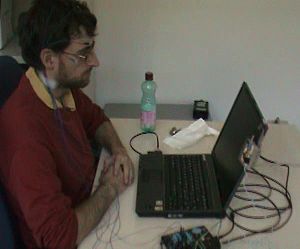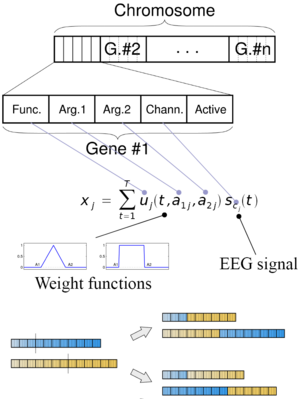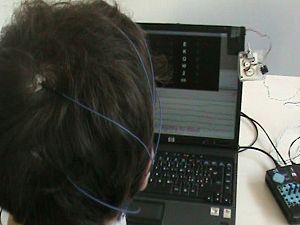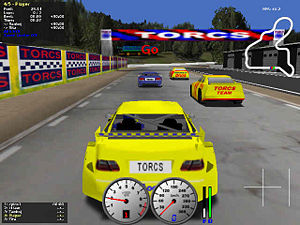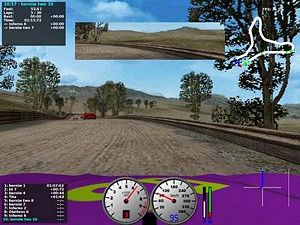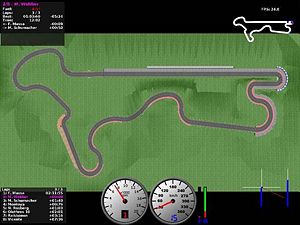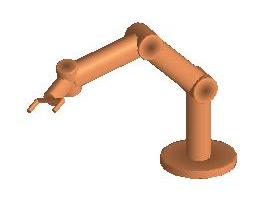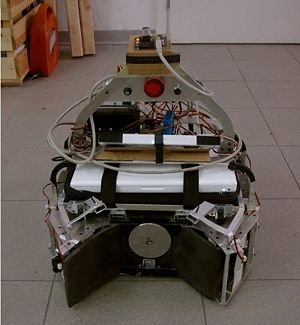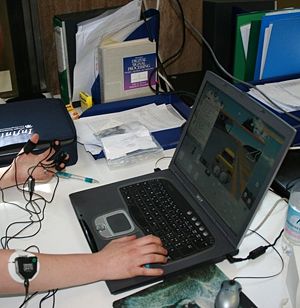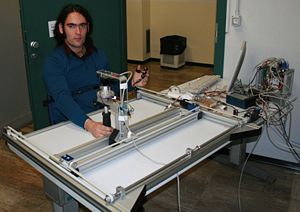Difference between revisions of "First Level Theses"
(→Brain-Computer Interface) |
(→Brain-Computer Interface) |
||
| Line 13: | Line 13: | ||
;Tools and instruments | ;Tools and instruments | ||
:Matlab, [http://www.bci2000.org/ BCI2000], C++ | :Matlab, [http://www.bci2000.org/ BCI2000], C++ | ||
| + | :EEG system | ||
;Bibliography | ;Bibliography | ||
| Line 30: | Line 31: | ||
:C++, Matlab, [http://www.bci2000.org/ BCI2000] | :C++, Matlab, [http://www.bci2000.org/ BCI2000] | ||
:Good programming skill required | :Good programming skill required | ||
| + | :EEG system | ||
;Bibliography | ;Bibliography | ||
| Line 46: | Line 48: | ||
:C++, C, [http://www.bci2000.org/ BCI2000], Matlab | :C++, C, [http://www.bci2000.org/ BCI2000], Matlab | ||
:Linux | :Linux | ||
| + | :EEG system | ||
| + | :Lurch wheelchair | ||
;Bibliography | ;Bibliography | ||
| Line 62: | Line 66: | ||
;Tools and instruments | ;Tools and instruments | ||
:C++, [http://www.bci2000.org/ BCI2000], Matlab | :C++, [http://www.bci2000.org/ BCI2000], Matlab | ||
| + | :EEG system | ||
;Bibliography | ;Bibliography | ||
Revision as of 18:43, 13 October 2008
Here you can find proposals for first level thesis (7.5 CFU for each student)
Contents
BioSignal Analysis
Brain-Computer Interface
| Title: | Real-time removal of ocular artifact from EEG | |
|---|---|---|
| Description: | In a BCI based on electroencephalogram (EEG), one of the most important sources of noise is related to ocular movements. Algorithms have been devised to cancel the effect of such artifacts. The project consists in the in the implementation in real time of an existing algorithm (or one newly developed) in order to improve the performance of a BCI.
| |
| Tutor: | Matteo Matteucci (email), Bernardo Dal Seno (email) | |
| Start: | Anytime | |
| Number of students: | 1 | |
| CFU: | 10-20 |
| Title: | Development of an existing genetic algorithm for ERP-based BCIs | |
|---|---|---|
| Description: | Different event-related potentials (ERPs) are used in BCIs, e.g., P300 and error potentials.
A genetic algorithm (GA) for ERP feature extraction has been developed at the Airlab. The GA has been proved to work, but there different ways that can explored to further develop this algorithm and expand its application field.
| |
| Tutor: | Matteo Matteucci (email), Bernardo Dal Seno (email) | |
| Start: | Anytime | |
| Number of students: | 1 | |
| CFU: | 5-20 |
| Title: | Driving an autonomous wheelchair with a P300-based BCI | |
|---|---|---|
| Description: | This project pulls together different Airlab projects with the aim to drive an autonomous wheelchair (LURCH) with a BCI, through the development of key software modules. The work will be validated with live experiments.
| |
| Tutor: | Matteo Matteucci, Bernardo Dal Seno | |
| Start: | November 2008 | |
| Number of students: | 1 | |
| CFU: | 5-20 |
| Title: | Online automatic tuning of the number of repetitions in a P300-based BCI | |
|---|---|---|
| Description: | In a P300-based BCI, (visual) stimuli are presented to the user, and the intention of the user is recognized when a P300 potential is recognized in response of the desired stimulus. In order to improve accuracy, many stimulation rounds are usually performed before making a decision. The exact number of repetitions depends on the user and the goodness of the classifier, but it is usually fixed a-priori. The aim of this project is to adapt the number of repetitions to changing conditions, so as to achieve the maximum accuracy with the minimum time.
The work will be validated with live experiments.
| |
| Tutor: | Matteo Matteucci, Bernardo Dal Seno | |
| Start: | Anytime | |
| Number of students: | 1 | |
| CFU: | 5-20 |
| Title: | Reproduction of an algorithm for the recognition of error potentials | |
|---|---|---|
| Description: | Error potentials (ErrPs) are event-related potentials present in the EEG (electroencephalogram) when a subject makes a mistake or when the machine a subject is interacting with works in an expected way. They could be used in the BCI field to improve the performance of a BCI by automatically detecting classification errors.
The project aims at reproducing algorithms for ErrP detection from the literature.
| |
| Tutor: | Matteo Matteucci, Bernardo Dal Seno | |
| Start: | Anytime | |
| Number of students: | 1 | |
| CFU: | 5-15 |
Machine Learning
| Title: | Learning API for TORCS | |
|---|---|---|
| Description: | TORCS is a state-of-the-art open source racing simulator that represents an ideal bechmark for machine learning techniques. We already organized two successfull competitions based on TORCS where competitors have been asked to develop a controller using their preferred machine learning techniques. The goal of this project is to extend the existing C++ API (available here) to simplify the development of controller using a learning framework.
Such an extension can be partially developed by porting an existing Java API for TORCS that already provides a lot of functionalities for machine learning approaches. | |
| Tutor: | Daniele Loiacono (loiacono-AT-elet-DOT-polimi-DOT-it) | |
| Start: | Anytime | |
| Number of students: | 1 to 2 | |
| CFU: | 5 to 12.5 |
| Title: | EyeBot | |
|---|---|---|
| Description: | TORCS is a state-of-the-art open source racing simulator that represents an ideal bechmark for machine learning techniques. We already organized two successfull competitions based on TORCS where competitors have been asked to develop a controller using their preferred machine learning techniques. So far, the controller developed for TORCS used as input only information extracted directly from the state of the game. The goal of this project is to extend the existing controller API (see here) to use the visual information (e.g. the screenshots of the game) as input to the controllers. A successfull project will include both the development of the API and some basic imaga preprocessing to extract information from the images. | |
| Tutor: | Daniele Loiacono (loiacono-AT-elet-DOT-polimi-DOT-it), Alessandro Giusti (giusti-AT-elet-DOT-polimi-DOT-it), and Pierluigi Taddei (taddei-AT-elet-DOT-polimi-DOT-it) | |
| Start: | Anytime | |
| Number of students: | 1 to 2 | |
| CFU: | 5 to 12.5 |
| Title: | SmarTrack | |
|---|---|---|
| Description: | The generation of customized game content for each player is an attractive direction to improve the game experience in the next-generation computer games. In this scenario, Machine Learning could play an important role to provide automatically such customized game content.
The goal of this project is to apply machine learning techniques for the generation of customized tracks in TORCS, a state-of-the-art open source racing simulator. The project include different activities: the automatic generation of tracks, the section of relevant features to characterize a track and the analysis of an interest measure. | |
| Tutor: | Daniele Loiacono (loiacono-AT-elet-DOT-polimi-DOT-it) | |
| Start: | Anytime | |
| Number of students: | 1 to 2 | |
| CFU: | 5 to 12.5 |
| Title: | TORCS competition | |
|---|---|---|
| Description: | TORCS is a state-of-the-art open source racing simulator that represents an ideal bechmark for machine learning techniques. We already organized two successfull competitions based on TORCS where competitors have been asked to develop a controller using their preferred machine learning techniques.
The goal of this project is to apply any machine learning technique to develop a successfull controller following the competition rules (available here) | |
| Tutor: | Daniele Loiacono (loiacono-AT-elet-DOT-polimi-DOT-it) | |
| Start: | Anytime | |
| Number of students: | 1 to 2 | |
| CFU: | 5 to 12.5 |
Robotics
| Title: | Simulation of 6-DOF Robot Manipulator | |
|---|---|---|
| Description: | The goal of this project is to develop a simulator for a 6-DOF robot manipulator, using the ode (open dynamics engine) library for simulating the rigid body dynamics. The project involves three different phases:
This project allows to put into practice what has been explained during the first part of the course of Robotics. The project can be turned into a thesis, by using the simulated manipulator to perform some learning experiments. | |
| Tutor: | Marcello Restelli (restelli-AT-elet-DOT-polimi-DOT-it) | |
| Start: | Anytime | |
| Number of students: | 2-3 | |
| CFU: | 10-15 |
| Title: | Robot games | |
|---|---|---|
| Description: | The goal of this activity is to develop an interactive game with robots using commercial devices such as the WII Mote (see the Robogames page)
Projects are available in different areas:
These projects allow to experiment with real mobile robots and real interaction devices. Parts of these projects can be considered as course projects. These projects can also be extended to cover course projects. | |
| Tutor: | Andrea Bonarini (bonarini-AT-elet-DOT-polimi-DOT-it) | |
| Start: | Anytime | |
| Number of students: | 1-2 | |
| CFU: | 7.5-12.5 |
Affective Computing
| Title: | Affective VideoGames | |
|---|---|---|
| Description: | The goal of this activity is to develop an interactive video game (Car game, Shoot them up, Strategic game ..) able to adapt its behaviour in order to maximize your enjoyment. The game will measure your excitement by analizing your biological signals, which mirror your emotional state. The system will be able to adjust some parameters (i.e difficulty of car game circuits, opponets strength ...) in order to keep you egnagemet constant: "In your flow zone!".
Project phases:
These projects allow to experiment with biological-data acquisition tools and videogames design. The project consists on the realization of one or more phases depending on the difficulty/cfu to be achieved and to the competences of the candidate(s) | |
| Tutor: | Cristiano Alessandro (alessandro-AT-elet-DOT-polimi-DOT-it), Simone Tognetti (togetti-AT-elet-DOT-polimi-DOT-it) | |
| Start: | Anytime | |
| Number of students: | 1 to 3 | |
| CFU: | 2.5 to 20 |
| Title: | Affective recognition in multimedia contexts | |
|---|---|---|
| Description: | The goal of this activity is to develop an interactive multimedia application (advertisement, e-learning, reccomenadation system) able to capture your emotional state (interests, excitement, anger, joy) while whatching to images, sounds etc. The application will measure your excitement by analizing your biological signals, which mirror your emotional state. The system could be used to give feedback on the quality of multimedia content (i.e goodness of the advertisement, enjoyment of the movie ...)
Project phases:
These projects allow to experiment with biological-data acquisition tools and multimedia application design. The project consists on the realization of one or more phases depending on the difficulty/cfu to be achieved and to the competences of the candidate(s) | |
| Tutor: | Cristiano Alessandro (alessandro-AT-elet-DOT-polimi-DOT-it), Simone Tognetti (togetti-AT-elet-DOT-polimi-DOT-it) | |
| Start: | Anytime | |
| Number of students: | 1 to 3 | |
| CFU: | 2.5 to 20 |
| Title: | Affective robotics | |
|---|---|---|
| Description: | The goal of this activity is to develop an rehabilitation robotic game able to capture your emotional state (interests, excitement, anger, joy, stress) while intereacting with the robot. The application will measure your excitement by analizing your biological signals, which mirror your emotional state. The system could be used to adapt the therapy (executed by the game) according to the patien's needs. We believe the quality of the theraphy is related to the subject's emotional state. The long term goal is to keep the user into a specific emotional state in order to maximize the theraphy efficacy.
Project phases:
These projects allow to experiment with biological-data acquisition tools, robots and videogame design. The project consists on the realization of one or more phases depending on the difficulty/cfu to be achieved and to the competences of the candidate(s) | |
| Tutor: | Cristiano Alessandro (alessandro-AT-elet-DOT-polimi-DOT-it), Simone Tognetti (togetti-AT-elet-DOT-polimi-DOT-it) | |
| Start: | Anytime | |
| Number of students: | 1 to 3 | |
| CFU: | 2.5 to 20 |
| Title: | Driving companions | |
|---|---|---|
| Description: | The goal of this activity is to develop an application that is able to capture your emotional state (stress, attention level .. ) while driving standard cars. The application will measure the driver's stress level by analizing his biological signals, which mirror the phisiological state, and could be used to give feedbacks to the driver in dangerous situations.
Project phases:
These projects allow to experiment with biological-data acquisition tools, robots and videogame design. The project consists on the realization of one or more phases depending on the difficulty/cfu to be achieved and to the competences of the candidate(s) | |
| Tutor: | Cristiano Alessandro (alessandro-AT-elet-DOT-polimi-DOT-it), Simone Tognetti (togetti-AT-elet-DOT-polimi-DOT-it) | |
| Start: | Anytime | |
| Number of students: | 1 to 3 | |
| CFU: | 2.5 to 20 |
